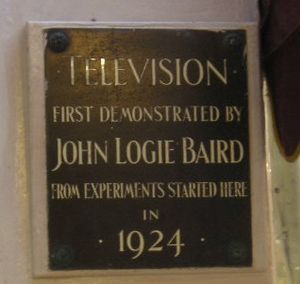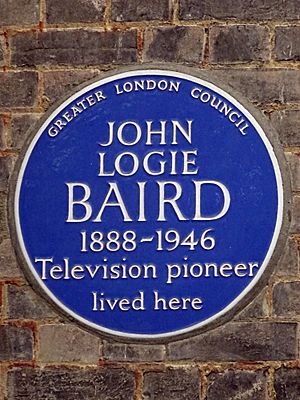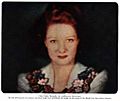John Logie Baird facts for kids
Quick facts for kids
John Logie Baird
FRSE
|
|
|---|---|
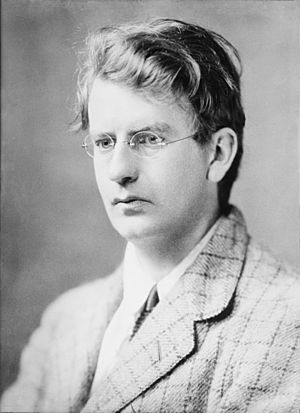
Baird in 1917
|
|
| Born | 13 August 1888 Helensburgh, Argyll and Bute, Scotland
|
| Died | 14 June 1946 (aged 57) Bexhill, Sussex, England
|
| Resting place | Baird family grave in Helensburgh Cemetery |
| Nationality | Scottish |
| Citizenship | British |
| Education | Larchfield Academy, Helensburgh |
| Alma mater | Royal Technical College (now University of Strathclyde), Glasgow |
| Occupation | Inventor businessman |
| Organization | Consulting Technical Adviser, Cable & Wireless Ltd (1941–) director, John Logie Baird Ltd director, Capital and Provincial Cinemas Ltd |
| Known for | One of the inventors of television, including the first colour television. |
| Spouse(s) | Margaret Albu (m. 1931) |
| Children | Diana Baird and Malcolm Baird |
| Parent(s) | Rev John Baird, Minister, West Kirk, Helensburgh Jessie Morrison Inglis |
| Notes | |
|
Member of the Physical Society (1927)
Member of the Television Society (1927) Honorary Fellow of the Royal Society of Edinburgh (1937) |
|
John Logie Baird (born August 13, 1888 – died June 14, 1946) was a Scottish engineer and inventor. He is famous for being one of the people who invented television. He showed the first working TV system in 1926. He also invented the first color television system and a special electronic color TV picture tube.
In 1928, his company sent the first TV signal across the Atlantic Ocean. Baird's early work helped bring broadcast television into homes. This earned him an important place in television's history.
Baird was named one of the 10 greatest Scottish scientists ever. This was part of the 'Scottish Science Hall of Fame'. He was also inducted into the Scottish Engineering Hall of Fame in 2015.
Contents
Early Life and Education
John Logie Baird was born in Helensburgh, Scotland. He was the youngest of four children. His father, Reverend John Baird, was a minister. His mother was Jessie Morrison Inglis.
He went to Larchfield Academy in Helensburgh. He also studied at the Glasgow and West of Scotland Technical College. Later, he attended the University of Glasgow.
During his studies, Baird worked in engineering. The tough conditions in Glasgow at that time affected his health. His degree course was stopped by the First World War. He never finished his degree.
In 1915, he tried to join the British Army. But he was not fit for duty. So, he took a job with an electrical power company. This company was making supplies for the war.
Developing Television
Many inventors worked on developing television. Baird was a key pioneer in this field. He made big steps forward. Many people believe Baird was the first to create a live, moving TV image. This image showed shades of grey using reflected light.
Baird achieved this by using a better photoelectric cell. He also improved how the signal from the cell was processed.
First Public Demonstrations
Baird showed moving silhouette images on TV for the first time. This happened at Selfridges department store in London. It was a series of demonstrations starting on March 25, 1925.
On October 2, 1925, Baird made a big breakthrough. In his lab, he successfully sent the first TV picture with shades of grey. The image was the head of a dummy called "Stooky Bill". It had 30 lines and showed five pictures per second.
Baird then brought an office worker, William Edward Taynton, to his lab. Taynton became the first person to be televised with full tones.
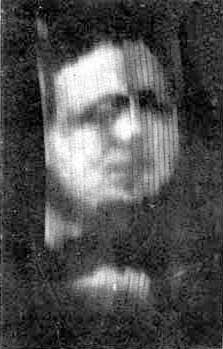
On January 26, 1926, Baird showed his invention again. He did this for members of the Royal Institution and a reporter from The Times. This demonstration was in his lab in Soho, London. By then, he had improved the speed to 12.5 pictures per second. This was the first time a TV system could broadcast live moving images with different tones.
He showed the world's first color TV transmission on July 3, 1928. The demonstration featured a young girl wearing different colored hats.
Broadcasting Television
In 1927, Baird sent a TV signal over 438 miles (705 km). This was between London and Glasgow. It was the world's first long-distance television picture.
Baird then started the Baird Television Development Company Ltd. In 1928, this company made the first TV transmission across the Atlantic Ocean. It went from London to Hartsdale, New York. They also made the first TV program for the BBC.
Later, Baird's mechanical TV systems were replaced. Newer electronic TV systems became more common. But Baird continued to work on electronic television. In 1939, he showed color television using a special tube called a cathode ray tube.

Other Inventions
Some of Baird's early inventions were not successful. When he was in his twenties, he tried to make diamonds. He heated graphite to do this, but it caused a power outage in Glasgow. Later, Baird made a glass razor. It was designed not to rust, but it broke easily.
Later Years and Legacy
From 1944, John Logie Baird lived in Bexhill-on-Sea, England. He died there on June 14, 1946, after having a stroke. He is buried with his family in Helensburgh Cemetery in Scotland.
Honors and Recognition
The Logie Awards for Australian television are named after John Logie Baird. This honors his important work in inventing television.
In 2014, the Society of Motion Picture and Television Engineers (SMPTE) recognized Baird. They added him to their Honor Roll. This is for people whose contributions were very important.
On January 26, 2016, Google created a special Google Doodle. This marked 90 years since Baird's first public TV demonstration.
Images for kids
-
This live image of Paddy Naismith was used to demonstrate Baird's first all-electronic colour television system.
See also
 In Spanish: John Logie Baird para niños
In Spanish: John Logie Baird para niños



